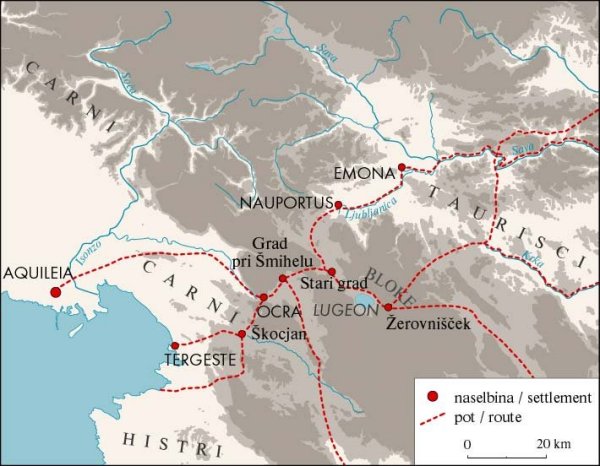 Institute of Archaeology Institute of Archaeology |
[Slovenian] |
| Home | Members | Programme | Projects | Laboratory |
| Database | Publications | Library | Links | Archive |
|
OCRA RAZDRTO, OCRA AND ROUTES LEADING ACROSS THE ALPS
Archaeological finds from the Notranjska region indicate that the Roman transport across Razdrto increased by the mid 2nd century BC at the latest. It seems that the Roman transport routes were directed across the Alps into Noricum and across Razdrto towards the Sava river valley at the same period of time; this was the case soon after (or simultaneously) the roads that connected Aquileia and Italy were built in the mid 2nd century BC. By the end of the 2nd century BC all four transport routes across the Alps (across the passes Monte Croce Carnico, Camporosso, Predel and Razdrto) were in use. In the mid 1st century BC new administrative centres and posts (Iulium Carnicum, Forum Iulii, Tergeste and Nauportus) were established at the key traffic positions, and this strengthened the Roman control over the routes. As they were not spatially linked to any of the existing indigenous settlements and did not show any contact with the surroundings even with their small objects the posts in the Razdrto area (Mandrga, Preval) from the end of the 2nd and first half of the 1st century BC differ from the other sites along the east Alpine routes. Most of the remains can be explained as traces of Roman passengers who stopped at Razdrto for a shorter period of time and not as remnants of a significant Roman settlement. As noticed from the archaeological records the transport flow at Razdrto ran mainly from Italy towards the east. A gravel covered road was constructed across the Razdrto pass in the second half of the 1st century BC or in the Augustan period. A roadside building was erected in the middle or late Augustan period and demolished in the mid 1st century AD. When the new road across Hrušica plateau was constructed in the first half of the 1st century AD the road across Razdrto became a minor road. The shift of transit from Razdrto to Hrušica obviously took place gradually, but consistently. Post 1st century AD written sources no longer mention the road across Ocra, and the archaeological remains dating after the mid 1st century AD are extremely modest. *** 2009, (Opera Instituti Archaeologici Sloveniae, 17), 248 pgs., 64 colour photos, 66 b-w drawings, photos, graphs and maps,13 tables, 52 plates, 20 x 29 cm, hardback, ISBN 978-961-254-163-7. |
